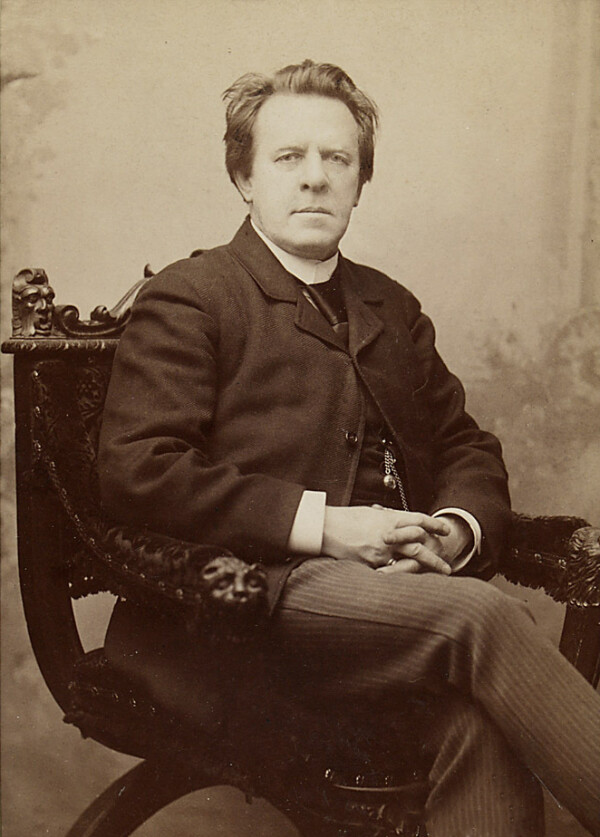Josef Lewinsky

Josef Lewinsky photographed by Josef Szekely, around 1895, Theatermuseum Vienna
© KHM-Museumsverband
For 48 years, the celebrated actor Josef Lewinsky was an ensemble member of the Vienna Burgtheater, where he played 300 roles. Gustav Klimt created a portrait of Josef Lewinsky as Carlos in Clavigo, one of his most successful roles, for the Society of Fine Art Reproduction in 1895.
Josef Lewinsky was born in Vienna on 20 September 1835 to Josef Lewinsky, a master furrier, and Theresia Stadler. He attended the Schottengymnasium private school for five years and the Vienna Polytechnic Institute for one year. After the death of his father in 1852, he discontinued his education and turned to acting.
He took his first acting lessons with Wilhelm Just, who helped him make a living as an extra at the Burgtheater and several suburban theaters. His first engagement at the Theater an der Wien in 1854 failed, however. He went on to work at the city theater in Troppau [now Opava] and the summer arena in Bielitz-Biala [now Bielsko-Biała]. In 1858, he played the role of Franz Moor in Brünn [now Brno] and was invited by Heinrich Laube to play the same role at the Vienna Burgtheater. This marked his breakthrough and was followed by one of his most famed performances as Carlos in Goethe’s play Clavigo.
Celebrated as one of Vienna’s best-known actors, Lewinsky received the title of Court Actor in 1865 and won the position of “real” director in charge of tragedy in 1872. He made his final appearance on stage as the Bishop of Bamberg in the play Götz von Berlichingen on 6 May 1906.

Josef Lewinsky in Maria Magdalena, photographed by Szekely & Massak. From left to right: Charlotte Wolter, Josef Lewinsky, Fritz Krastel, 24.11.1869, Theatermuseum, Vienna
© KHM-Museumsverband

Role portrait of Josef Lewinsky as Carlos in Clavigo, around 1895, Theatermuseum, Vienna
© KHM-Museumsverband
Lewinsky was an ensemble member of the Vienna Burgtheater for 48 years, playing approximately 300 roles ranging from villains to character parts. Late in life, he had great success in comedic roles and performed in folk plays. His greatly psychologized approach to performing and speaking revolutionized acting, which is why he is considered a trailblazer of modern dramatic art. He was also successful as a reciter, touring the German-speaking countries with his second wife Olga Precheisen, who was also an actress at the Burgtheater, and even traveling to Moscow and Saint Petersburg in 1898. Furthermore, Lewinsky wrote theoretical essays on poetry and acting.
In 1894, Gustav Klimt was commissioned by the Society of Fine Art Reproduction to create a portrait of a famous actor of the Vienna Court Theater for the luxurious publication Die Theater Wiens (vol. II, part 3). It was intended to serve as a template for an illustration in the second volume Das k. k. Hofburgtheater. Klimt decided on Josef Lewinsky. The then 60-year-old actor posed for him in his most successful role as Carlos from the play Clavigo. Since it took a year to complete work on the painting and Lewinsky went on tour during this period, Klimt partly painted from photographs.
Josef Lewinsky died on 27 February 1907. He was laid to rest at the protestant cemetery in Vienna-Simmering, 11th District.
Literature and sources
- Österreichisches Biographisches Lexikon. Josef Lewinsky. www.biographien.ac.at/oebl/oebl_L/Lewinsky_Josef_1835_1907.xml (04/09/2020).
- Deutsche Biographie. Josef Lewinsky. www.deutsche-biographie.de/sfz50907.html (04/09/2020).
- Wien Geschichte Wiki. Josef Lewinsky. www.geschichtewiki.wien.gv.at/Josef_Lewinsky (12/29/2019).
- Brief von Gustav Klimt in Wien an Josef Lewinsky (19.05.1894). H.I.N. 38.571, .
- Brief von Gustav Klimt in Wien an Josef Lewinsky (Anfang Juli 1895). H.I.N. 38.573, .
- Brief von Gustav Klimt in Wien an Josef Lewinsky (vermutlich 28.06.1895). H.I.N. 38.572, .

